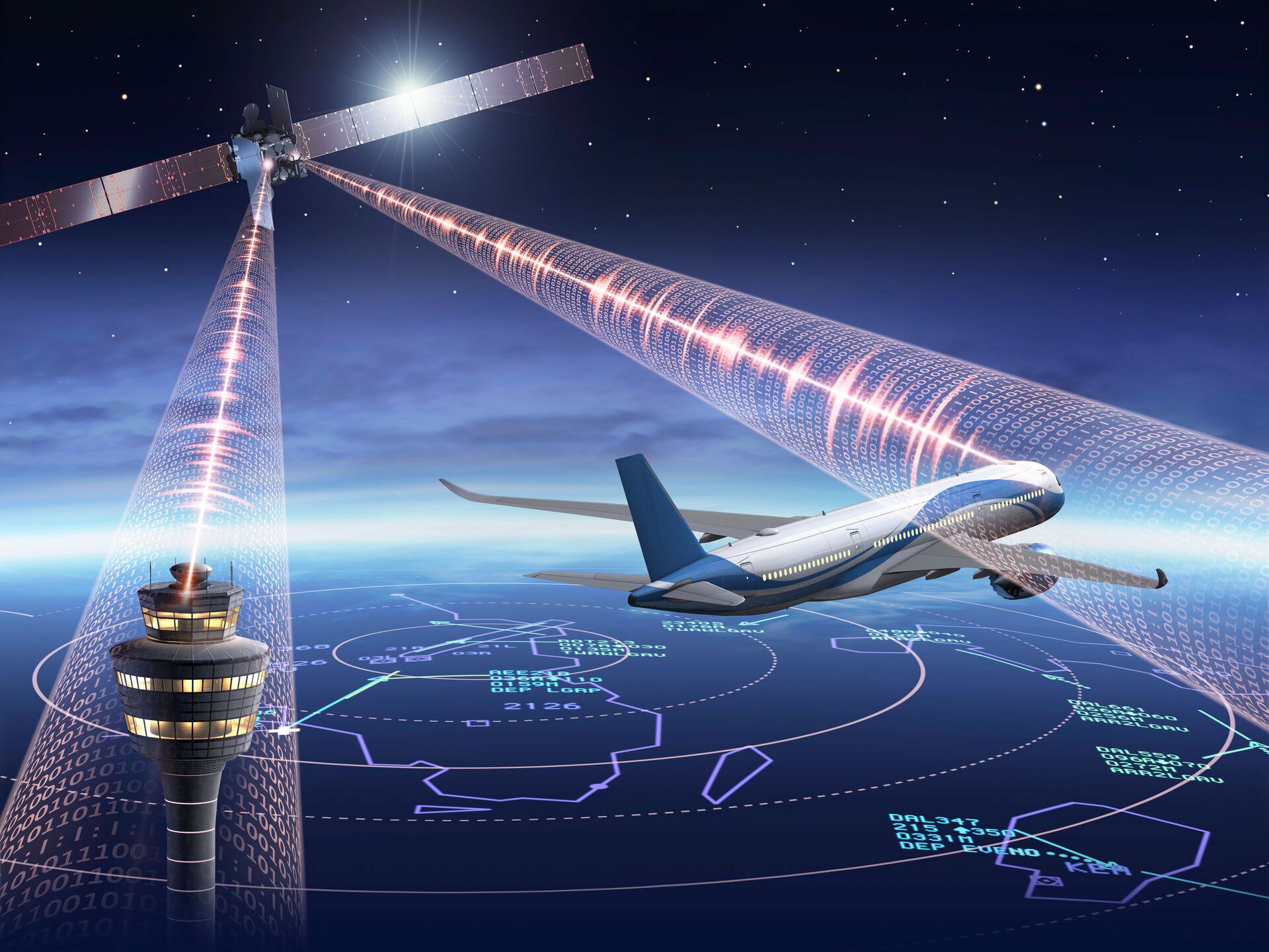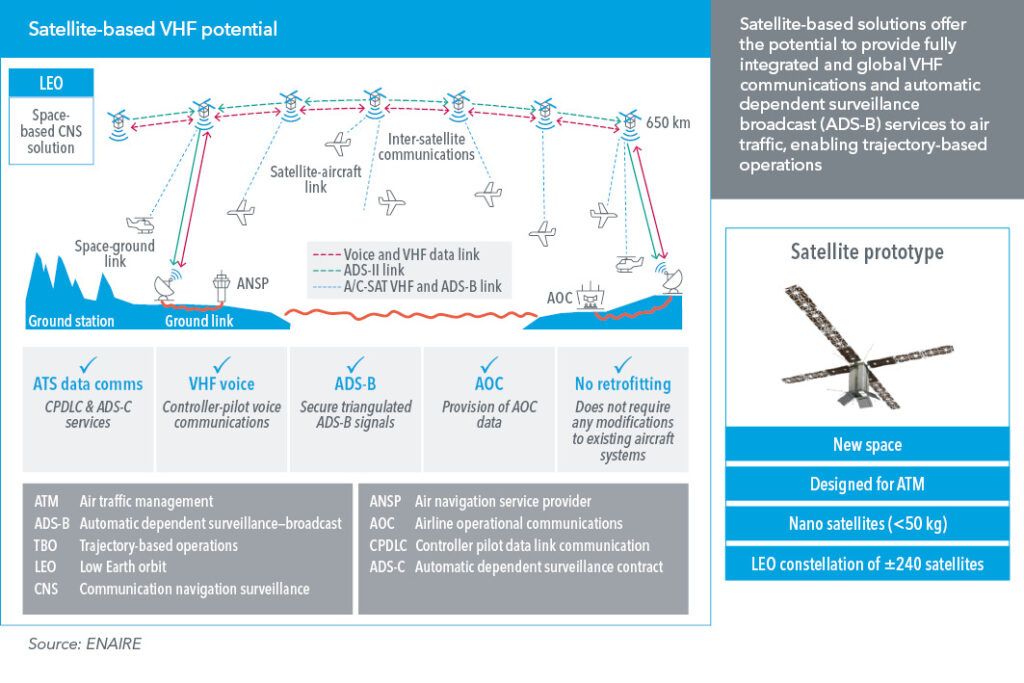
VHF communications with aircraft via aeronautical mobile satellite


Manuel García Martín, Chief, Spanish Air Navigation (ENAIRE) Communications Division
Space-based very high frequency (VHF) communications would enable aircraft to communicate with air traffic control (ATC) via satellite radio links operated in the aeronautical mobile-satellite (route) service (AMS(R)S).
The concept is expected to support flight operations in many areas of the world, particularly in oceanic and remote zones. It will complement current aviation navigation and surveillance technologies, like automatic dependent surveillance (ADS).
Enhancing communications in oceanic and remote areas
Current technologies for long-range communications, such as high frequency (HF) and conventional satellite links, may not provide the level of performance needed to safely support close aircraft-to-aircraft separation in a similar way as terrestrial VHF communications. The satellite-based technology will overcome these constraints in oceanic and remote areas, where deploying VHF terrestrial infrastructure is unpractical.
The figure below illustrates the space-based VHF communication concept. The space segment is able to receive and transmit to standard VHF radios already installed on aircraft and is designed to behave like a VHF‑tower located in the sky, with a larger footprint than terrestrial towers. Satellite-based VHF communications also require feeder links operating in a different fixed-satellite frequency band.

ITU studies
The need for such satellite-based VHF communications was discussed in the previous study cycle of the ITU Radiocommunication Sector (ITU-R — one of three Sectors of the International Telecommunication Union), resulting in a new agenda item 1.7 for the upcoming World Radiocommunication Conference, WRC‑23.
Under this agenda item, ITU has the task to define the relevant technical characteristics, study the compatibility between proposed AMS(R)S systems within the 117.975–137 megahertz (MHz) band and existing primary services in adjacent bands, and allocate necessary spectrum for the new technology.
Importantly, the space-based VHF concept is based on the use of existing airborne equipment. The system will be able to interact with standard on‑board ADS‑B (Automatic Dependent Surveillance–Broadcast) and VHF systems, both for VHF digital data links and voice communications.
The benefits
The space-based VHF concept for air traffic management promises major operational benefits.
These include:
- the use of the same operational procedures for air traffic controllers in continental and oceanic areas;
- important gains in safety for aircraft operation in oceanic and remote continental areas;
- a significant increase in communication capacity in oceanic and remote areas;
- no additional training for air traffic controllers, as operation is the same as in aeronautical terrestrial VHF communications;
- no additional avionics required in aircraft;
- a significant reduction in fuel combustion and therefore fewer carbon dioxide (CO2) emissions owing to optimized and efficient routes;
- increased situational awareness for air traffic controllers, who would have more accurate information about aircraft positions.
Importantly, the voice and digital data communications between air traffic controllers and pilots would continue to function as they do now. While the use of new platforms would be transparent, air traffic controllers and pilots would not need to distinguish between communications supported by terrestrial or space-based technology.
Testing feasibility and compatibility
Administrations and the aeronautical industry — including avionics system providers, aircraft manufacturers, satellite industries and operators — have been examining the feasibility of the new concept, as well as its compatibility with existing systems operating in the same and adjacent bands.
Several conclusions have emerged:
- Satellite-based voice and datalink services could be integrated into the existing ground infrastructure using current operational procedures, without any modification in current avionics.
- Satellite-based voice and data services could coexist with current terrestrial aeronautical services.
- Satellite-based voice and digital data services can also coexist with adjacent band services and without adverse impact to those services.
The satellite-based VHF concept will be a bridge to the future. The associated infrastructure would offer the potential to keep up with evolving technology and support the International Civil Aviation Organization (ICAO) “No Country Left Behind” initiative.
What’s expected at WRC‑23
Future satellite-based VHF communications will require the allocation of the entire band 117.975–137 MHz to AMS(R)S, including the upper end. This is because aeronautical terrestrial digital data links operate in the upper part of the band, and the frequency 136.975 MHz is used for the data link signalling and control channel.
WRC‑23 therefore needs to ensure that the future AMS(R)S can operate in the whole frequency band, allowing for future provision of both voice and data services.
Download your copy of the ITU News Magazine: Land, sea and airwaves.
Header image credit: ESA
